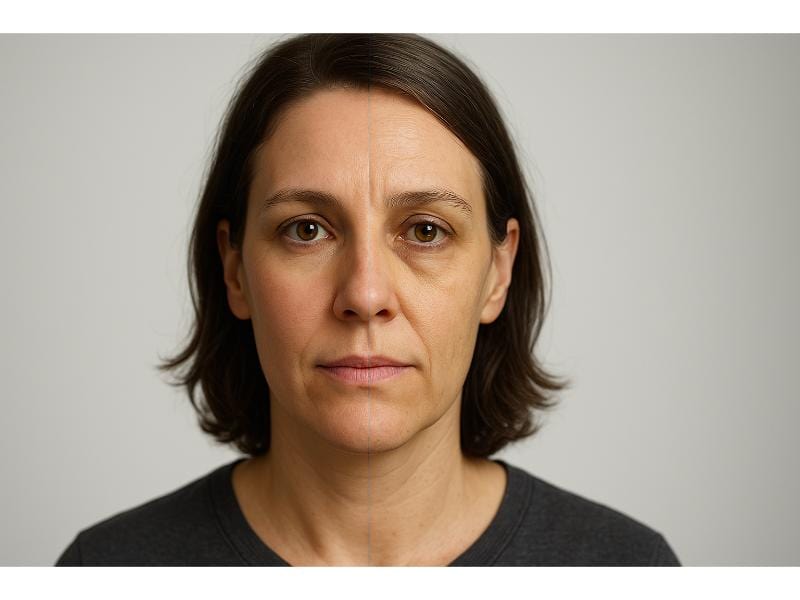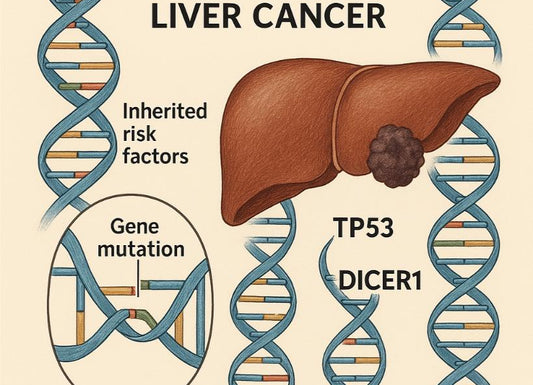How to Detect Early Liver Damage? Preventing Progression
 Written By
Jaclyn P. Leyson-Azuela, RMT, MD, MPH
Written By
Jaclyn P. Leyson-Azuela, RMT, MD, MPH

More than 100 million Americans have some form of liver disease. But early detection through symptoms and tests can prevent progression to cirrhosis or failure. Symptoms of early liver disease are easily attributed to other conditions or factors like stress. But it could be a warning that your body is telling you. The good news? Catching liver problems early gives you the opportunity to reverse the damage and protect your overall long-term health.
This article will guide you through recognizing the signs, understanding the causes, and knowing when to seek medical help. Your liver health affects everything from energy levels to immune function.
Key Insights
-
Early liver damage often shows subtle signs like persistent fatigue and yellowing of the eyes before obvious symptoms develop
-
Non-alcoholic fatty liver disease affects 1 in 3 US adults, making it more common than alcohol-related liver problems
-
Basic liver function tests are relatively affordable and can detect problems 5-10 years before serious complications arise
-
Fatty liver cases are reversible with diet changes and modest weight loss of 5-10%
-
People with diabetes, obesity, or family history should get annual liver screening regardless of symptoms
-
Elevated ALT levels above 40 IU/L serve as an early warning sign requiring medical evaluation
What Are the Early Signs and Symptoms of Liver Damage?

Liver disease is often called a “silent condition” because symptoms don’t always appear until the disease is advanced. However, subtle changes can emerge in the early stages if you know what you are looking for. So, recognizing these signs gives you the potential to act before any permanent damage occurs.
Why Early Symptoms Are Hard to Spot
The liver works quietly in the background, filtering toxins, regulating blood sugar, producing bile for digestion, and storing nutrients. The liver is so efficient that it may lose a large portion of its function before obvious, recognizable symptoms arise. This means that the early signs are usually mild and non-specific. The early signs may even be mistaken for some other issues like daily fatigue or minor digestive problems.
What Are The Common Early Symptoms?
While each person may experience liver strain differently, some of the most frequent early warning signs include:
-
Persistent fatigue–often present in 65-85% of patients and is not relieved even after adequate rest
-
Mild yellowing of the skin and eyes, which is due to the buildup of bilirubin. Often this symptom may not be present for all patients in the early stages
-
Upper right abdominal discomfort usually felt as pain or pressure
-
Digestive changes, such as loss of appetite, nausea or vomiting, especially after eating fatty meals
-
Changes in urine color (dark, cola-colored)
-
Changes in stool color (clay-colored)
-
Fluid retention and swelling (due to decrease in protein production) usually seen on the legs, ankles, or abdomen
-
Easy bruisability
-
Cognitive issues, such as difficulty concentrating, mental fog, or confusion
Not everyone will experience all these signs, and many symptoms can overlap with other health problems. The key here is persistence and vigilance. If these issues don’t improve over time then they should be taken more seriously.
How Does Fatigue Indicate Early Liver Damage?
Fatigue is one of the earliest signs and most common signs of liver disease. Unlike fatigue from lack of sleep, the exhaustion felt from liver damage doesn’t improve with rest. It occurs because a struggling liver cannot effectively filter toxins from the blood, leaving the body in a constant state of stress. People often described it as “bone-deep tiredness” that interferes with their daily lives.
If you find yourself consistently needing frequent naps, struggling with focus, or noticing fatigue coupled with other digestive issues, it’s time to consider your liver as a possible source.
What Causes Jaundice in Early Liver Damage?
Jaundice is one of the few liver-related symptoms that’s physically visible. It develops when the liver fails to process bilirubin, which is a yellow pigment produced from the breakdown of red blood cells. In its early stages, jaundice often appears in the eyes or mucosa before it spreads out as generalized jaundice.
Note that people with darker skin tones may find eye checks especially important since skin changes can be less noticeable.
Coupled with dark urine and pale stools, jaundice is a strong indicator that liver evaluation is necessary immediately.
How Can Abdominal Swelling Signal Liver Issues?
Abdominal Swelling and Tenderness
Swelling in the upper abdomen, medically termed as ascites, involves fluid and may occur in early liver disease. Unlike digestive bloating, which waxes and wanes throughout the day, liver-related swelling tends to persist and may be accompanied by leg or ankle swelling. Your clothes may feel tighter around the waist area. Or, you may find your meals easily filling you up even after smaller portions.
Because many of these symptoms are vague, they are often dismissed until more severe damage occurs. But awareness is critical. Recognizing these early signs, especially when combined with known risk factors, can prompt early testing and intervention. This is where regular checkups and tools like at-home liver function tests become valuable. They allow you to catch problems years before advancing to a more serious condition.
What Causes Liver Damage and Who Is at Risk?
Understanding what causes liver damage is just as important as recognizing symptoms. The liver is remarkably resilient. But repeated exposure to certain stressors or underlying health conditions gradually wears it down. Most liver diseases develop over years, often silently, before serious complications appear. By identifying your personal risk factors, you can take proactive steps to protect this vital organ.
What Are The Major Categories of Liver Damage?

Liver damage can stem from four broad categories: alcohol-related causes, metabolic conditions, viral infections, and toxins or medications.
1. Alcohol-related damage
Excessive alcohol consumption remains a leading cause of liver disease. The liver processes alcohol into less harmful substances, but this ability has limits. Consuming more than the liver can handle leads to fat buildup and inflammation. Over time, this develops into fibrosis and eventually cirrhosis.
-
Drinking more than 14 units per week is considered high risk for liver damage
-
For women, the threshold is much lower than men with heavy drinking defined as 8 or more drinks per week
-
Binge drinking is defined as five or more drinks in a two-hour period for men and four for women. This adds further strain to the liver, even when it is infrequent
2. Non-alcoholic causes (metabolic conditions)
Non-alcoholic fatty liver disease (NAFLD) is now the most common liver disorder in the United States, affecting nearly one in three adults. Unlike alcohol-related disease, NAFLD is driven by metabolic factors such as:
-
Obesity or a body mass index (BMI) over 30
-
Type 2 diabetes or prediabetes
-
High cholesterol and triglycerides
-
High blood pressure and metabolic syndrome (a cluster of the above conditions)
These conditions overwhelm the liver with fat and sugar, causing fat to build up in liver cells. Over time, this triggers inflammation and scarring.
3. Viral and infectious causes
Hepatitis viruses are another major contributor.
-
Hepatitis B and C are transmitted through blood contact, unprotected sex, or sharing needles. Both can cause chronic infection that damages the liver silently for decades.
-
Hepatitis A spreads through contaminated food or water. While typically acute, severe cases may strain the liver significantly
-
Autoimmune hepatitis occurs when the body’s immune system mistakenly attacks liver cells, leading to inflammation and injury
4. Medications and toxins
Even common over-the-counter and prescription drugs can harm the liver when taken in excess or for prolonged periods.
-
Acetaminophen (Tylenol) is safe at recommended doses but toxic if over 3,000 mg is taken daily for an extended period
-
Cholesterol-lowering statins
-
Specific antibiotics
-
Some anti-seizure drugs
-
Herbal supplements aren’t always harmless (some of them will contain compounds that are toxic to the liver)
-
Occupational exposure to industrial chemicals, solvents, or pesticides can contribute to long-term liver damage
Who Is Most at Risk?
While liver disease can affect anyone, certain groups face higher risk and should be especially vigilant.
-
Adults more than 40 years old with obesity and diabetes have significantly higher chance of developing fatty liver disease
-
People with family history of liver conditions may inherit genetic predispositions
-
Those with long-term alcohol use, even at moderate levels increase their risk if combined with obesity or other conditions.
-
Hispanic and Asian populations have higher rates of fatty liver disease, likely due to genetic and metabolic differences.
-
Women may experience liver effects at lower alcohol intake and BMI thresholds compared to men, partly due to hormonal influences.
Alcohol vs. Metabolic Causes: Different but Overlapping Risks
Alcohol-related liver damage and non-alcoholic fatty liver disease share some common outcomes but differ in how they develop.
-
Alcohol damage can appear rapidly with heavy use but is often fully reversible if drinking stops in the early stages.
-
Metabolic liver disease progresses more slowly, often silently, and requires long-term lifestyle changes rather than simple abstinence.
Despite these differences, the conditions can overlap. For example, someone with obesity who also drinks heavily faces a compounded risk, with damage progressing more quickly than with either factor alone.
Knowing your risk profile allows for smarter prevention. People with diabetes, obesity, or a family history of liver disease should consider annual liver function tests, even if no symptoms are present. Likewise, anyone with a history of heavy drinking, hepatitis exposure, or long-term medication use should discuss liver monitoring with their healthcare provider.
When combined with early detection methods such as at-home liver testing kits, understanding your personal risk helps ensure problems are identified years before they become irreversible.
How Do Doctors Diagnose Early Liver Damage?
Because early liver damage can be so subtle, diagnosis relies heavily on medical testing rather than symptoms alone. The good news is that most forms of liver disease can be detected through simple, routine screenings. If you fall into a higher-risk category, or notice persistent symptoms such as fatigue, jaundice, or abdominal swelling, getting tested is one of the most important steps you can take.

How Doctors Diagnose Early Liver Damage
Doctors typically follow a step-by-step process to determine whether liver damage is present and how advanced it might be:
Medical history and physical exam
Your doctor will ask about lifestyle factors (alcohol use, medications, supplements), existing conditions (diabetes, high blood pressure), and family history. A physical exam may include checking for tenderness in the upper right abdomen, swelling in the legs or stomach, and signs of jaundice in the eyes or skin.
Blood tests (liver function tests, or LFTs)
These are the frontline tools for liver screening. They measure specific enzymes and proteins that reveal how well your liver is functioning:
-
ALT (Alanine Aminotransferase): Elevated levels above 40 IU/L often indicate early liver cell injury.
-
AST (Aspartate Aminotransferase): Supports ALT findings, though it is less specific to the liver.
-
Bilirubin: High levels cause jaundice and signal impaired processing.
-
Albumin: Low levels suggest reduced protein production and declining function.
-
Alkaline Phosphatase: Elevated levels may point to bile duct obstruction or liver inflammation.
Together, these values provide a picture of liver health. Mild elevations may be reversible with lifestyle changes, while higher levels often require close monitoring and treatment.
Imaging studies
If blood tests raise concerns, imaging may be ordered to visualize liver structure:
-
Ultrasound: Non-invasive and effective for spotting fatty deposits or enlargement.
-
CT scan or MRI: Provide more detailed images for detecting tumors, scarring, or advanced changes.
-
FibroScan: A specialized ultrasound that measures liver stiffness, helping determine the extent of fibrosis.
Advanced testing
In some cases, a biopsy may be needed to confirm diagnosis and assess damage. This involves taking a small sample of liver tissue for microscopic examination.
The Role of At-Home Liver Tests
In recent years, at-home liver testing kits have become an accessible option for people who want to monitor their liver health between doctor visits. These tests typically involve a simple finger-prick blood sample mailed to a certified lab. Results often include levels of ALT, AST, and other key markers.
While they can’t replace a professional diagnosis, at-home tests provide several benefits:
-
Convenience
-
Early detection
-
Monitoring
-
Cost-effective:
These kits can act as an early warning system, encouraging timely medical follow-up when abnormalities appear. For anyone with risk factors, such as obesity, diabetes, or a history of alcohol use, adding at-home liver testing to routine checkups may provide extra peace of mind.
Studies show that liver function tests can identify problems 5–10 years before serious complications like cirrhosis or liver failure occur. This window is crucial because early-stage liver disease, such as fatty liver or mild fibrosis, is often completely reversible with diet, exercise, and lifestyle adjustments.
By combining professional evaluation with modern tools like at-home liver tests, individuals can stay ahead of silent damage and take action when it matters most.
Can Early Liver Damage Be Reversed or Prevented?
One of the most encouraging facts about liver health is that early damage is often reversible. Unlike many organs, the liver has a remarkable ability to regenerate if the underlying cause of damage is addressed in time. The key lies in identifying problems early, making targeted lifestyle changes, and following through with medical treatment when necessary.
Can Early Liver Damage Be Reversed?
Yes. In its earliest stages, fatty liver, inflammation, or mild fibrosis, liver damage can often be completely reversed. Once scarring becomes advanced (cirrhosis), the changes are largely permanent, though progression can still be slowed.
-
Fatty liver (Stage 1): Reversible with even 5-10% weight loss, diet changes, and exercise within 3–6 months.
-
Inflammation (Stage 2): Often reversible with consistent medical and lifestyle interventions.
-
Early fibrosis (Stage 3): Some reversal possible over 1–2 years, though minor scarring may remain.
-
Cirrhosis (Stage 4): Permanent scarring, but treatment can prevent further damage and complications.
This makes early detection, through symptoms, risk awareness, and testing, absolutely critical.
Medical Treatments
Treatment varies depending on the cause of damage. Doctors may prescribe:
-
Antiviral medications for hepatitis B or C. Modern drugs for hepatitis C can cure infection in 8–12 weeks with success rates above 95%.
-
Medications for autoimmune hepatitis, including corticosteroids and immunosuppressants.
-
Targeted therapies for fatty liver disease, such as pioglitazone (for patients with diabetes) or vitamin E in some cases.
-
Supportive treatments like ursodeoxycholic acid for bile duct disorders.
For many patients, however, lifestyle changes remain the cornerstone of treatment.

Lifestyle Changes for Liver Health
1. Nutrition
The Mediterranean diet is consistently recommended for liver health. It emphasizes whole, nutrient-dense foods and minimizes processed ingredients.
-
Beneficial foods: Leafy greens, fatty fish (salmon, sardines), nuts, seeds, berries, olive oil, coffee, and green tea.
-
Foods to limit: Sugary drinks, refined grains, fried foods, processed meats, and excess alcohol.
Even modest dietary improvements can yield measurable benefits. Research shows that losing 5–10% of body weight can significantly reduce liver fat and improve enzyme levels.
2. Exercise
Physical activity helps reduce liver fat and improves insulin sensitivity, a major factor in metabolic liver disease.
-
Aim for 150 minutes of moderate exercise per week, such as brisk walking, swimming, cycling, or yoga.
-
Add resistance training two to three times weekly to build muscle and improve metabolism.
3. Alcohol moderation
For individuals with liver disease, reducing alcohol intake is non-negotiable. In early stages of alcohol-related liver damage, abstinence can completely reverse fatty liver in just weeks.
4. Medication safety
Take medications exactly as prescribed and avoid exceeding safe limits on over-the-counter drugs like acetaminophen. Always consult your doctor before starting supplements, as some can harm the liver.
Prevention Strategies
Protecting liver health doesn’t just mean treating damage. It also involves prevention:
-
Maintain a healthy weight through a balanced diet and exercise.
-
Get vaccinated against hepatitis A and B.
-
Avoid risky behaviors that increase hepatitis C exposure (e.g., sharing needles, unlicensed tattoos).
-
Use protective equipment if exposed to industrial chemicals at work.
-
Schedule regular blood work and consider at-home liver tests if you fall into higher-risk categories.
Doctors often stress that while medications and treatments can help, long-term success depends heavily on patient commitment. People who actively manage their diet, exercise, and alcohol consumption often see the most dramatic improvements in liver function.
By combining medical care with sustainable lifestyle changes, many people can not only reverse early liver damage but also dramatically lower their risk of future complications.
When Should You See a Doctor for Liver Concerns?
Because liver disease often progresses silently, it’s important not to wait until symptoms become severe. Early evaluation can make the difference between simple lifestyle changes and a lifelong struggle with advanced disease. Knowing when to seek medical advice, and which risk factors demand immediate attention — helps ensure problems are caught before they escalate.
When to Seek Medical Care
If you notice persistent or worsening symptoms, schedule an appointment with your healthcare provider. Symptoms that warrant medical attention include:
-
Ongoing fatigue lasting more than two weeks
-
Yellowing of the eyes or skin (jaundice)
-
Dark urine or pale stools
-
Persistent nausea, vomiting, or loss of appetite
-
Abdominal swelling or tenderness, particularly on the right side
-
Easy bruising or unexplained bleeding
-
Mental fog, confusion, or difficulty concentrating
Even if these symptoms seem mild, they should not be ignored. They often represent the early stages of liver dysfunction.
Who Needs Routine Evaluation?
Beyond obvious symptoms, some individuals should undergo regular liver function testing due to their higher risk profile. These include:
-
Adults over 40 with diabetes, obesity, or metabolic syndrome
-
People with a family history of liver disease
-
Anyone with a history of regular or heavy alcohol use
-
Individuals taking long-term medications known to affect the liver
-
People who have tested positive for hepatitis viruses
For these groups, annual blood work is a simple yet powerful way to stay ahead of silent liver changes.
High-Priority Risk Factors Requiring Prompt Testing
Certain risk factors increase the likelihood of developing liver problems so significantly that testing should be a priority, even in the absence of symptoms. These include:
-
Excessive alcohol use
-
Metabolic syndrome
-
Family and genetic history
-
Medication or supplement use
-
Occupational or environmental
Research shows that people who undergo liver evaluation within six months of noticing symptoms experience significantly better outcomes than those who delay. Even when results are normal, testing provides reassurance and establishes a baseline for future monitoring.
For those at higher risk, at-home liver tests can serve as a convenient first step. Abnormal results should always be followed up with professional evaluation, but these kits allow individuals to monitor their health proactively between doctor visits.
In short, if you have risk factors or early symptoms, the best time to act is now. The earlier liver problems are identified, the greater the chance of full recovery.
Quick Summary Box
-
Persistent fatigue, yellowing of eyes or skin, abdominal swelling, dark urine, pale stools, and unexplained bruising.
-
Adults over 40 with diabetes, obesity, or family history of liver disease; people with long-term alcohol use; those on medications that affect the liver.
-
Basic liver function panels (ALT, AST, bilirubin, albumin), often available for $50–$200. Imaging like ultrasound may follow abnormal results.
-
Provide convenient, affordable access to enzyme monitoring but should complement, not replace, medical evaluation.
-
A Mediterranean-style diet, regular exercise, weight management, and limited alcohol can prevent or reverse early liver damage.
-
Most early liver problems are reversible. The sooner issues are detected, the higher the chance of full recovery.
References
Alebna, P. L., Gowtham Grandhi, Shetty, N., Mannan, A., Chew, N., Dixon, D. L., Blaha, M. J., Arora, P., Siddiqui, M., Sanyal, A., & Mehta, A. (2023). Abstract 15983: Association of Cardiovascular Health With Nonalcoholic Fatty Liver Disease in American Adults. Circulation, 148(Suppl_1). https://doi.org/10.1161/circ.148.suppl_1.15983
Almahmoud, M. H., Al Khawaja, N. M., Alkinani, A., Khader, Y., & Ajlouni, K. M. (2021). Prevalence of fatty liver disease and its associated factors among Jordanian patients with type 2 diabetes mellitus: A cross-sectional study. Annals of Medicine and Surgery, 68, 102677. https://doi.org/10.1016/j.amsu.2021.102677
American Heart Association. (2020). Mediterranean Diet. Www.heart.org; American Heart Association. https://www.heart.org/en/healthy-living/healthy-eating/eat-smart/nutrition-basics/mediterranean-diet
American Heart Association. (2024, January 19). American Heart Association Recommendations for Physical Activity in Adults and Kids. American Heart Association. https://www.heart.org/en/healthy-living/fitness/fitness-basics/aha-recs-for-physical-activity-in-adults
Carstensen, J., & Balakhrishnan, M. (n.d.). Non-Alcoholic Fatty Liver Disease-A Guide to What & How to Eat. Https://Www.bcm.edu/Sites/Default/Files/A-Guide-To-What-And-How-To-Eat-Non-Alcoholic-Fatty-Liver-Disease.pdf. Retrieved September 5, 2025, from https://www.bcm.edu/sites/default/files/a-guide-to-what-and-how-to-eat-non-alcoholic-fatty-liver-disease.pdf
CDC. (2024, April 1). Clinical Care of Hepatitis C. Hepatitis C. https://www.cdc.gov/hepatitis-c/hcp/clinical-care/index.html
Gerber, L. H., Weinstein, A. A., Mehta, R., & Younossi, Z. M. (2019). Importance of fatigue and its measurement in chronic liver disease. World Journal of Gastroenterology, 25(28), 3669–3683. https://doi.org/10.3748/wjg.v25.i28.3669
John Hopkins Medicine. (2024). Ascites. Www.hopkinsmedicine.org. https://www.hopkinsmedicine.org/health/conditions-and-diseases/ascites
Lala, V., Minter, D. A., & Zubair, M. (2023). Liver Function Tests. Nih.gov; StatPearls Publishing. https://www.ncbi.nlm.nih.gov/books/NBK482489/
Litten, R., Kwako, L., & Gardner, M. (2024, February 27). The basics: Defining how much alcohol is too much | National Institute on Alcohol Abuse and Alcoholism (NIAAA). Www.niaaa.nih.gov. https://www.niaaa.nih.gov/health-professionals-communities/core-resource-on-alcohol/basics-defining-how-much-alcohol-too-much
Moriles, K. E., Zubair, M., & Azer, S. A. (2020). Alanine Amino Transferase. In www.ncbi.nlm.nih.gov. StatPearls Publishing. https://www.ncbi.nlm.nih.gov/books/NBK559278/
NHS. (2022, January 19). The risks of drinking too much. Nhs.uk. https://www.nhs.uk/live-well/alcohol-advice/the-risks-of-drinking-too-much/
Osna, N. A., Donohue, T. M., & Kharbanda, K. K. (2017). Alcoholic Liver Disease: Pathogenesis and Current Management. Alcohol Research : Current Reviews, 38(2), 147. https://pmc.ncbi.nlm.nih.gov/articles/PMC5513682/
Sharma, A., & Nagalli, S. (2023, July 3). Chronic Liver Disease. PubMed; StatPearls Publishing. https://www.ncbi.nlm.nih.gov/books/NBK554597/
Swain, M. G. (2006). Fatigue in Liver Disease: Pathophysiology and Clinical Management. Canadian Journal of Gastroenterology, 20(3), 181–188. https://doi.org/10.1155/2006/624832
Zyoud, S. H. (2025). Global scientific research landscape on binge drinking: a comprehensive bibliometric and visualization analysis of trends, collaborations, and future directions. Substance Abuse Treatment Prevention and Policy, 20(1). https://doi.org/10.1186/s13011-025-00641-1

Jaclyn P. Leyson-Azuela, RMT, MD, MPH, is a licensed General Practitioner and Public Health Expert. She currently serves as a physician in private practice, combining clinical care with her passion for preventive health and community wellness.



